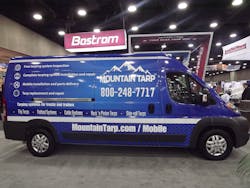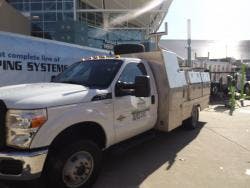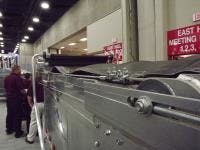LOUISVILLE. Around since 1989 when it was founded in Middlesboro, KY, focusing on the coal industry, Mountain Tarp has a track record of providing quality coverings for transportation. In 2012, the decision was made to expand the brand and broaden its customer base. Since that time, Mountain Tarp has been reaching out to customers of all types with tarping needs east of the Mississippi.
At this week’s Mid-America Trucking Show, Mountain Tarp announced a new service designed to better meet the needs of its customers. The company has purchased two Ram ProMaster vans to deliver product and repair parts to customers in seven states. That is in addition to five 2014 Ford F-350 pickups equipped with service bodies and equipment for mobile repairs and installations.
“What sets us apart from other tarp companies is that we will go to the customer,” said Chris Nicolazzo, vice president and general manager. “We can be onsite after hours and by the morning we can be done, have the vehicle tarp installed, and that truck can be back on the road making money.”
The service trucks are based in Middlesboro; Ashland, KY; Cincinnati; Houston; and Akron, OH. The new vans are staffed with two fulltime drivers running dedicated routes delivering product mostly to end users.
For those not familiar with Mountain Tarp, the company was acquired by Wastequip in 2006.
“We serviced the coal fields – that was our bread and butter,” Nicolazzo said. “Wastequip acquired us and the goal was to become a national company.”
The company now offers three main types of tarping systems – the flip tarp; the cable system; and the side to side. All tarps are custom made to fit vehicles properly.
The flip tarp is most commonly seen on dumps and typically used in applications hauling asphalt or landscape materials, Nicolazzo said. The cable system, rather than flipping over the dump, drags the tarp along the top of the dump on cables, ensuring a tighter fit. It is often spec’d for applications where losing product is a concern, such as grain, or where waterproofing is important, such as wood chips.
The third system is the side to side, which looks like the flip tarp but rather than pulling the tarp end to end, it pulls it to the side of the vehicle. These are most often used by grain haulers who are loading trailers in the fields. It makes loading easier.


